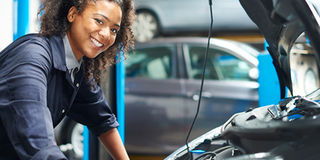Essential car checks to do every day

What you need to know:
Just before you start your car and leave home in the morning, these are the things you should do to keep your car long lasting.
It is quite easy to forget about servicing your car and keeping it properly maintained, especially when you are busy. However, you would also like to have problem-free rides and prevent your car from breaking down abruptly on the road, leading to expensive repair costs.
To enjoy longevity and maximum performance of your car, deliberately pay attention to the regular habit of maintaining your car. It might take a little of your time to give your car a quick check-up every day but these checks could prevent the speedy wear of your car.
Oil
Check the oil level on the dipstick. If your car uses a lot of oil, keep the oil topped up to the high mark. If it “uses” little or no oil between services, the level should be kept just above the low mark, to give slight economy and performance advantages. Check that the oil filler cap is secure and there are no leaks around the oil filter and engine joints.
Undo the radiator cap when the engine is cool. The water should reach the base of the cap. Do not always rely on the level in the expansion tank, although it will give you a quick visual reference at more frequent intervals. If the water is slightly murky, make a note to have the radiator flushed at the next service. If it is thick with muddy rust, get it flushed next time you refuel. The job is simple and takes just a few minutes.
Brakes
Check the brake fluid level. The reservoir should be absolutely full. Although the brakes will work perfectly well if it is less than full, it will be easier to spot any fluid loss if the level is always measured from the brim. Also, if the reservoir is always full, air is less likely to get into the system.
If ever you need to top up the brake fluid, even slightly, turn on a red light in your head. Make very careful and thorough follow-up checks of the brake system to establish why the level has gone down.
Battery
The fluid (electrolyte) level in each cell should cover the vertical plates inside. The caps should be clean and their breather holes should be clear. If the fluid needs topping up, use distilled water only. Never add ordinary tap water, even if it is sparkling clean, it will contain chemicals harmful to your battery, and never add acid.
The battery terminals should be tight and clean, with no “fur” on them. Make sure the battery brackets are secure but do not over tighten them since this distorts the battery casing and can cause cracks and leaks.
Distributor
If your car has a distributor, unclip the cap and check the metal contacts inside. The metal should ideally be shiny and not too worn (if they are corroded they can be polished clean with emery paper). The cap itself should fit securely, be clean, dry and have no cracks or chips. Check that the points are not dirty or pitted.
Fanbelt
Check the tension and condition. There should be about 2cm of play in the belt, mid-way between the pulleys. If it is tighter than that, it could damage the alternator and pulley bearings, and if it is looser, it could slip and break or fail to operate the alternator and water pump properly. A screeching noise just after you start the engine and rev up invariably denotes a loose belt.
Tyres
Look for cuts and bulges on the sidewalls, not forgetting the inside edge. If you find any cuts or bulges, the tyre should be replaced. Look for signs of unusual tread wear. One side wearing out faster than the other or a feathering effect on the trend require urgent remedial action.
Exhaust
With the engine at fast idle, block the end of the exhaust tailpipe with the palm of your hand or the sole of your shoe. If it continues to run, your exhaust has a leak that will become rapidly worse unless it is repaired.
Spotting weaknesses before they get serious will save you time and money, and might also save your life.
Keep your car clean
Before you take a ride out in your car in the morning, do a quick cleaning. Keeping your car clean is more than just about making your car look nice. It also makes your car last long. With every journey you embark on every day, your car is exposed to dust, grease, grime, and dirt. These could make your car rust and is dangerous to your health.
You can start with simple cleaning routines such as taking out the garbage, dusting the interior parts of your car; that is the dashboard, centre console, car seats, and floormats. Then, clean the outer parts such as the windscreen, side mirrors and headlights with washing fluids.
Source: naijauto.com





